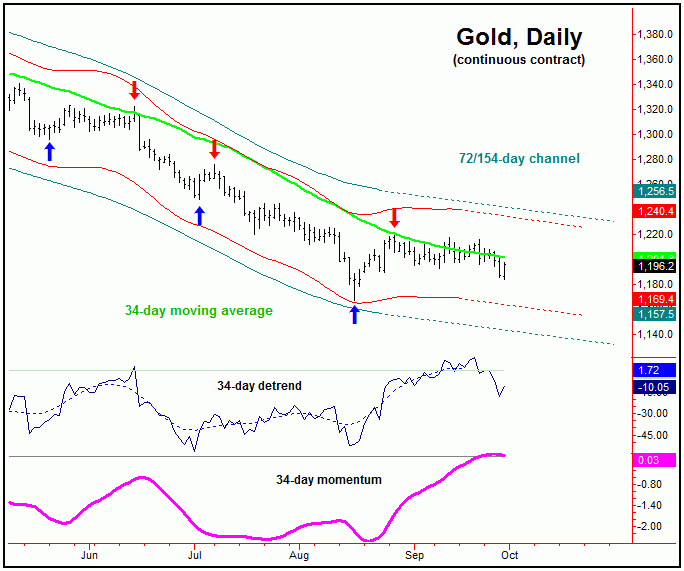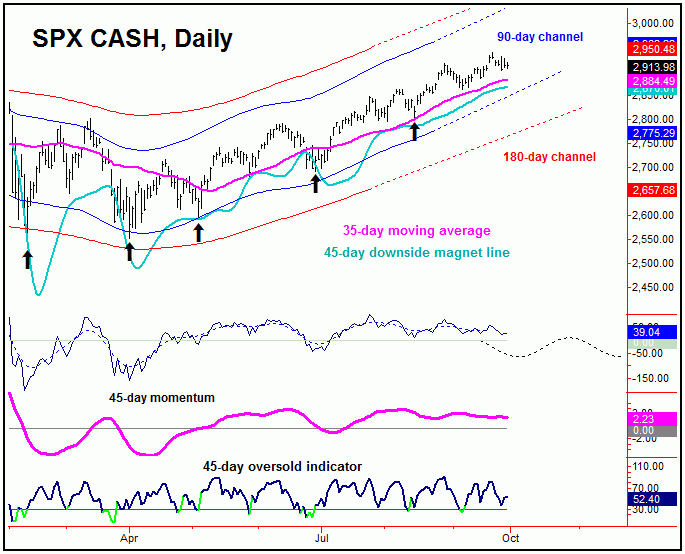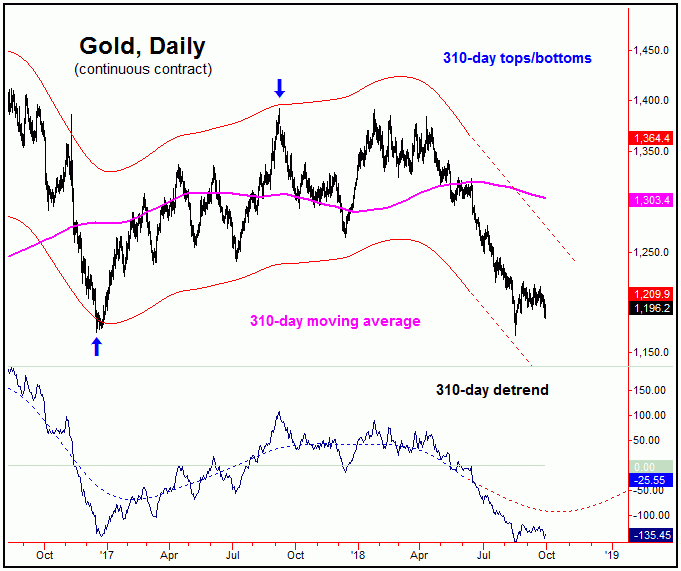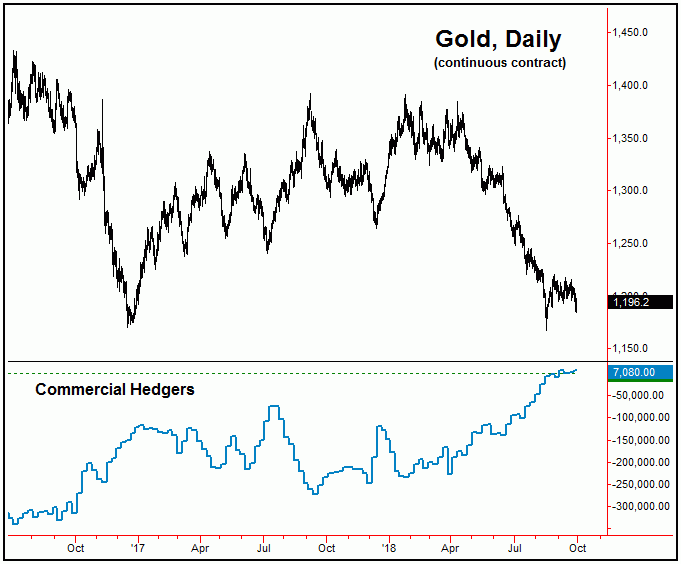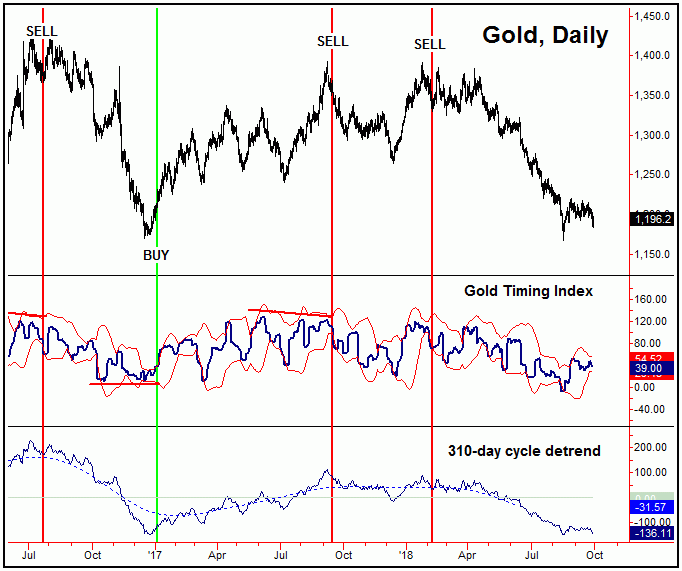Gold's Dominant Short-Term Cycle

The action from last week saw gold forming its high in Monday's session with the tag of the 1208.80 figure, before turning south into a Friday low of 1184.40 - before bouncing off the same to end the week. With that, the short-term cycles are seen as pointing lower, with the mid-term cycles having yet to confirm a bottom - and with that could have a lower low (for the larger swing) still out there.
For the gold market, the most dominant short-term cycle is the 34-day component, which has been fairly consistent in recent years. As mentioned in my prior article, this wave was some 25 trading days along - and with that was back into normal topping range. Our key price level for this 34-day component was noted as being the 1188.00 figure (December, 2018 contract), which was recently taken out to the downside.
In light of the above, until proven otherwise, gold’s downward phase of this 34-day cycle is currently deemed to be in force, with the cycle projecting its next low for the early-to-mid October timeframe:
If the above assessment is correct regarding the 34-day cycle, then the probabilities will favor additional weakness in the next week or two, before bottoming this wave for another rally phase into the month of November. In terms of price, there is the full potential for a hard test - or a break - below the 1167 swing bottom that was seen back in August.
The same cycle on the U.S. stock market looks like it has also topped out, and with that is heading south, with the 2860-2880's acting as a magnet:
The 35-day moving average and our 45-day cycle downside 'magnet' line will normally act as price magnets, with the bigger question being whether the 2863.00 SPX CASH figure will be able to contain that drop, which we see as a key dividing line going forward. Time will tell for the stock market.
Mid-Term For Gold
For the mid-term picture, the next larger upward phase has been expected to come from the 154 and 310-day time cycles. In terms of price, until a lower level materializes, gold (December, 2018 contract) would currently need to see a daily close back above the 1263.50 figure to confirm these waves to have troughed. Otherwise, below the same and a drop back below the 1167 swing bottom can still materialize in the days/weeks ahead.
If and when the next mid-term trough is set in place, we should see gold rallying back to the 310-day moving average or better (chart, above), though with that rally favored to remain below the September, 2017 peak of 1392.80. In other words, we should see that rally ending up as a countertrend affair, to be followed by lower lows on the next downward phase of the 310-day wave.
Commercial Hedgers
In going over the COT data from last week, the commercial hedgers (chart, above) have added another 5,000 longs, which brings their current net long total back up to 7,080 contracts - which is their highest in many years (normally, the hedgers hold varying degrees net short the market). As noted in past articles, the biggest argument for a strong mid-term rally phase is the current position of the hedgers. However, below the 1263.50 figure on a closing basis, and this rally could still come from a lower low than 1167, but with firm mid-term support now developing at the 1150's - which is 'swing support' on the weekly chart.
Gold Timing Index
Our Gold Timing Index (chart, above) is a sentiment/momentum measure for the gold market - and is my main indicator of trend direction for the mid-term. As mentioned in prior articles, this indicator tends to 'turn' with up and down phases of the 310-day cycle, which is the largest time cycle that I track. Thus, when this indicator is on a buy signal, we expect higher prices in the mid-term - and for any declines to end up as countertrend.
Conversely, when our Gold Timing Index is on a sell signal, we should expect any short-term rallies to end up as countertrend, and for lower prices to develop.
With the above said and noted, the Gold Timing Index has basically been on a mid-term sell signal since September of 2017 (just following the last semi-important peak with the 310-day cycle), with a repeat sell signal issued back in February of this year. And, all rallies since have ended up as countertrend moves.
Going further with the above, since no mid-term buy signal was seen following the 1167 swing bottom, we would have to favor that the price low for the 310-day wave is still out there - but only as long as the metal (December, 2018 contract) is able to remain below the 1263.50 figure on a closing basis.
Stepping back, in order for a mid-term buy signal to occur with our Timing index, gold would need to see a drop below the 1167 swing low, but with our indicator holding below its last bottom - in other words, a divergence between the indicator and price. The actual trigger, however, would be the indicator closing above its upper standard-deviation band.
For the short-term, I should add with the above that short-term sell signals come when the indicator is able to close above the upper standard-deviation band - while still on a mid-term sell signal. Thus, this indicator is currently on a short-term sell signal from the 8/27/18 close (i.e., 1216, December contract), until otherwise reversed by a close below its lower standard-deviation band.
Jim Curry
The Gold Wave Trader
http://goldwavetrader.com
http://cyclewave.homestead.com
********

